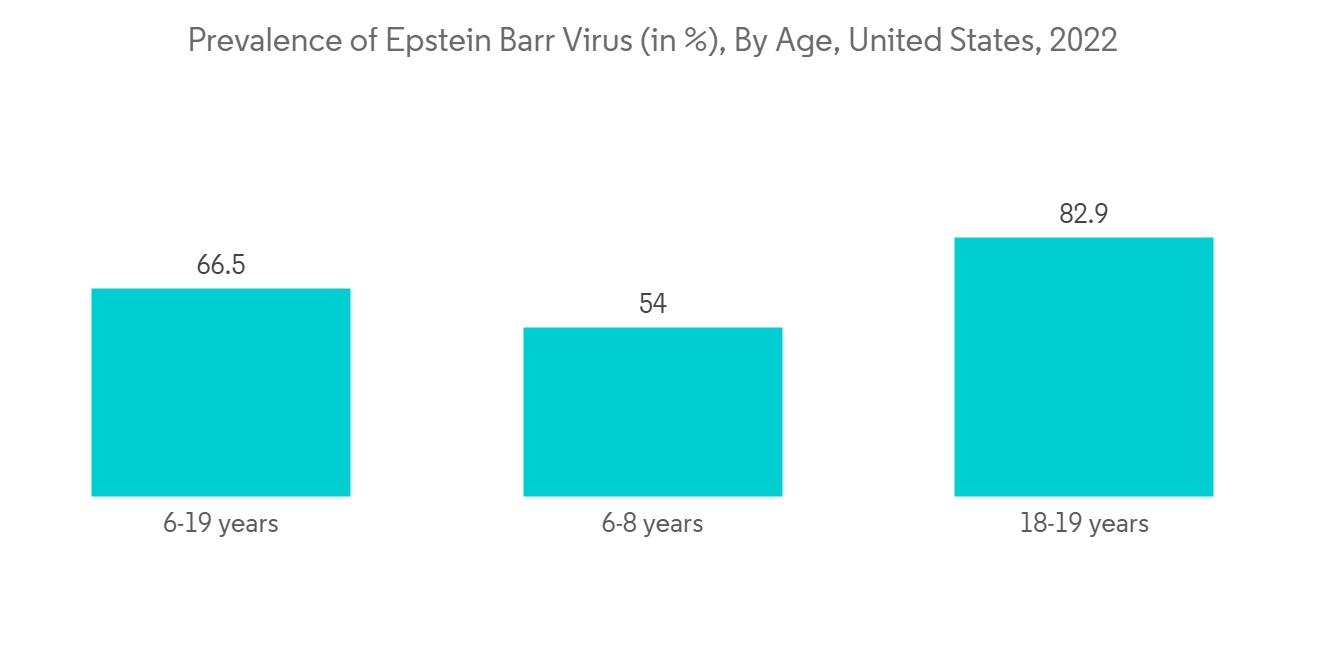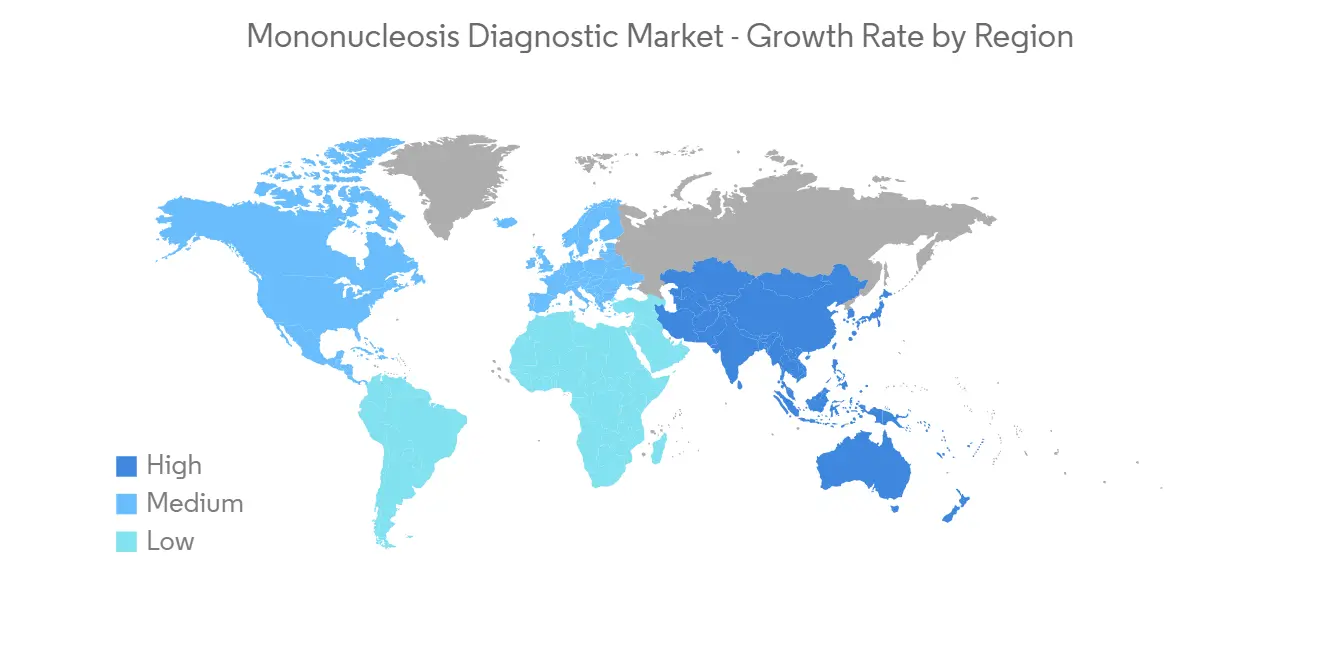 |
市場調査レポート
商品コード
1273404
単核球症診断市場- 成長、動向、予測(2023年-2028年)Mononucleosis Diagnostic Market - Growth, Trends, and Forecasts (2023 - 2028) |
||||||
● お客様のご希望に応じて、既存データの加工や未掲載情報(例:国別セグメント)の追加などの対応が可能です。 詳細はお問い合わせください。
| 単核球症診断市場- 成長、動向、予測(2023年-2028年) |
|
出版日: 2023年04月14日
発行: Mordor Intelligence
ページ情報: 英文 120 Pages
納期: 2~3営業日
|
- 全表示
- 概要
- 目次
予測期間中、単核球症診断市場のCAGRは約4.8%で成長すると予想されています。
COVID-19の大流行は、感染症の蔓延を抑えるために感染症の管理に重点を置くようになり、単核球症診断市場に大きな影響を与えました。これは、COVID-19がエプスタイン・バー・ウイルス(EBV)感染と関連していることに起因しています。例えば、BMC Infectious Diseasesが2021年9月に発表した論文によると、COVID-19の患者128人のうち、13.3%がエプスタイン・バーウイルス再活性化に感染していました。2022年2月に発表されたUniversity Health Networkによるアップデートでは、長いCOVID-19の症状は活動性のEBV感染でも見られ、COVID患者の70%近くがEBVの再活性化であったとしています。その上で、EBVの再活性化が長いCOVID-19の原因である可能性があるとしています。このように、このような研究や最新情報は、パンデミック時に患者集団のEBVを診断する需要が増加したことを示しています。また、COVID-19後の現在のシナリオでは、世界の規制が緩和され、病気のスクリーニングサービスが再開されたため、市場の成長は安定しつつあります。
世界の単核球症診断市場の成長の主な要因は、患者の健康意識と知識の向上、迅速な診断につながる技術の進歩、思春期の人口の増加などです。今後数年間は、これらの要因が市場の成長を後押しするものと思われます。
診断の迅速化につながる技術的進歩は、主に市場の成長を後押ししています。例えば、2021年4月、Roche社は、Elecsys EBV IgM、Elecsys EBV VCA IgG、Elecsys EBV EBNA IgGイムノアッセイから成るElecsys EBVパネルをCEマークを受け入れる国で発売しました。さらに、2022年1月、Quanterix Corporationは、同社のSimoa技術が多発性硬化症(MS)に関連するEBVの高い有病率を識別する上で重要であることが証明されたと報告しました。このように、単核球症診断市場における技術的進歩の拡大は、予測期間中の需要を増加させると予想されます。
さらに、Frontiers in Immunologyが2022年8月に発表した研究によると、指標日から10年以内に、MSの発症率は、感染性単核球症の患者では10万人年あたり22.6件であったが、感染性単核球症を持たない人では10万人年あたり11.9件しかないです。そのため、伝染性単核球症の患者数の増加は、今後数年間、本調査の市場拡大に寄与すると考えられます。
それでも、単核症を診断するための検査があまりないことが、市場の成長を加速させない大きな理由となっています。
単核球症診断の市場動向
予測期間中、検査タイプ別ではモノスポットテストセグメントが大きな市場シェアを占める見込み
検査タイプ別では、モノスポットテスト分野が大きな成長を遂げると予想されています。モノスポットテストは、ラテックス凝集試験で、主要基質としてウマ赤血球を利用し、EBV感染に応答してヒト免疫系が産生する特定の異種抗体を検査します。この検査は、他の検査との非干渉性、正確な結果、抗体の迅速な検出、費用対効果などの利点があるため、最大の市場シェアを占めると予想されます。さらに、2021年8月にStatPearlsに掲載された記事によると、単核球症は、ほぼ100%特異的なモノスポット(または異種抗体)検査で診断されます。このテストの感度は85%に近いです。このような研究により、患者さんの間でモノスポットテストが広く受け入れられるようになり、この分野の成長に寄与しています。
2021年11月にClinical Journal of Sports Medicineに掲載された研究によると、モノスポットテストの感度と特異度はそれぞれ80.0%と90.6%でした。トランスアミナーゼ値の上昇は、急性伝染性単核球症と強い相関があり、診断の助けとなる可能性があります。モノスポットテストの陽性結果は、感染性単核球症(IM)の診断に最も信頼できる方法です。したがって、高い感度と特異度が、今後数年間、このセグメントの成長に貢献すると考えられます。
しかし、エプスタイン・バーウイルス感染症の一次症状として、成人における伝染性単核球症は珍しいものです。これらの病気にかかりやすい10代の人口が、市場拡大の原動力になると予想されます。このように、上記の要因が予測期間中、このセグメントの成長を促進すると予想されます。

アジア太平洋地域が世界市場で最も高い成長率を占める
アジア太平洋地域は、単核球症診断市場において最も高い成長率を占めており、予測期間中も大きな変化はなく、同様の傾向を示すと予想されます。同地域ではEBVに感染しやすい思春期の人口が増加していることが、予測期間中の市場成長を促進する主要因の1つであると予想されます。例えば、2022年2月にLancetが発表した論文によると、単核症は主に思春期に発症する病気で、エプスタイン・バーウイルスによって引き起こされます。しかし、このウイルスは非常に流行しやすく、個人の人生において、まず3~4歳頃、そして15~16歳頃の2回、最大発生ピークを迎えるとされています。小児期にエプスタイン・バーウイルスが発症した場合、単核症を発症するリスクは非常に低いのですが、思春期になると大幅に高くなるのです。このことは、多くの人が自覚のないままエプスタイン・バー・ウイルスに感染していることを示しています。
さらに、国連児童基金によると、2022年1月、東アジア太平洋地域には、全世界の10代の約25%に当たる3億2,900万人の青少年が住むとされています。青少年人口の多さは、単核球症診断検査に対する大きな需要を示しています。さらに、2022年11月にVerywell Healthが発表した記事によると、米国では、社会経済的に低い環境に住む子どもの25%~50%が4歳までにEBVに感染しているとされています。さらに、若年成人の75%がEBV感染後にモノと診断されることになります。このことは、同地域でEBVに続いて単核症を発症するケースが増加していることと合わせて、予測期間中の市場の成長を押し上げると予想されます。
また、Cardinal Health社やAbbott社などの主要企業がこの地域に存在することも、市場の成長に寄与しています。この地域には10代の若者が多いため、今後数年間は大きな市場機会が多く存在すると考えられます。

単核球症診断業界の概要
単核球症診断市場は、大手と中小の両者によって支配されています。しかし、市場のニッチセグメントでは、小規模な市場プレーヤーは数社に過ぎません。Abbott Laboratories、Danaher Corporation、Thermo Fisher Scientific Inc.、Cardinal Health Inc.、Bio-Rad Laboratoriesなどの大手市場関係者は、より迅速な検出を実現するために、先端製品の開発に力を注いでいます。
その他の特典:
- エクセル形式の市場予測(ME)シート
- 3ヶ月間のアナリストサポート
目次
第1章 イントロダクション
- 調査の前提条件と市場定義
- 本調査の対象範囲
第2章 調査手法
第3章 エグゼクティブサマリー
第4章 市場力学
- 市場概要
- 市場促進要因
- 患者の健康意識と知識の向上
- 単核症の有病率の上昇
- 市場抑制要因
- 単核球症の診断に利用可能な検査法の限界
- ポーターのファイブフォース分析
- 新規参入業者の脅威
- 買い手/消費者の交渉力
- 供給企業の交渉力
- 代替品の脅威
- 競争企業間の敵対関係
第5章 市場セグメンテーション(金額ベース市場規模)
- 検査タイプ別
- モノスポットテスト
- 完全血球計数検査
- エプスタイン・バー・ウイルス(EBV)抗体検査
- エンドユーザー別
- 病院
- ラボラトリー
- その他のエンドユーザー
- 地域別
- 北米
- 米国
- カナダ
- メキシコ
- 欧州
- ドイツ
- 英国
- フランス
- イタリア
- スペイン
- その他欧州
- アジア太平洋地域
- 中国
- 日本
- インド
- オーストラリア
- 韓国
- その他アジア太平洋地域
- 中東・アフリカ地域
- GCC
- 南アフリカ
- その他中東とアフリカ
- 南米
- ブラジル
- アルゼンチン
- その他南米地域
- 北米
第6章 競合情勢
- 企業プロファイル
- Abbott Laboratories
- Arlington Scientific Inc.
- Bio-Rad Laboratories Inc.
- Cardinal Health Inc.
- Immunostics Inc.
- Meridian Bioscience
- Sekisui Diagnostics
- Thermo Fisher Scientific Inc.
- Launch Diagnostics Limited
- Beckman Coulter Inc.
- Diasorin
- BioMerieux
第7章 市場機会および将来動向
During the time frame of the forecast, the mononucleosis diagnostics market is expected to grow at a CAGR of nearly 4.8%.
The COVID-19 outbreak substantially impacted the mononucleosis diagnostics market as the pandemic increased the focus on the management of infectious diseases to limit their spread. This was attributed to the fact that COVID-19 was associated with Epstein-Barr virus (EBV) infections. For instance, as per an article published in September 2021 by BMC Infectious Diseases, out of the 128 patients with COVID-19, 13.3% were infected with Epstein-Barr virus reactivation. As per an update published in February 2022 by the University Health Network, long COVID-19 symptoms were also found in active EBV infections, and close to 70% of the COVID patients had reactivated EBV. It went on to say that EBV reactivation could be the cause of long COVID-19. Thus, such studies and updates indicate the demand for diagnosing EBV among the patient population increased during the pandemic. In addition, the market growth is stabilizing in the current scenario after COVID-19 as the worldwide restrictions have eased and the disease screening services have been resumed.
The major factors responsible for the growth of the global mononucleosis diagnostics market include rising health awareness and knowledge among patients, technological advancements leading to faster diagnosis, and the rise in the adolescent population. During the next few years, these factors are likely to continue to help the market grow.
Technological advancements leading to faster diagnosis are primarily driving the market's growth. For instance, in April 2021, Roche launched the Elecsys EBV panel, which consists of Elecsys EBV IgM, Elecsys EBV VCA IgG, and Elecsys EBV EBNA IgG immunoassays, in countries accepting the CE Mark. Additionally, in January 2022, Quanterix Corporation reported that its Simoa technology had been proven to be significant in identifying a high prevalence of EBV associated with multiple sclerosis (MS). Thus, growing technological advances in the mononucleosis diagnostics market are expected to increase demand over the forecast period.
Moreover, as per the study published in August 2022 by Frontiers in Immunology, within 10 years from the index date, the incidence of MS was 22.6 cases per 100,000 person-years among patients with infectious mononucleosis but only 11.9 cases per 100,000 person-years among individuals without infectious mononucleosis. So, the growing number of cases of mononucleosis is likely to help the study market grow over the next few years.
Still, the fact that there aren't many tests for diagnosing mononucleosis is a big reason why the market isn't growing faster.
Mononucleosis Diagnostic Market Trends
The Monospot Test Segment by Test Type is Expected to Hold the Significant Market Share During the Forecast Period
By test type, the monospot test segment is expected to witness significant growth. The monospot test is a latex agglutination test that utilizes equine erythrocytes as the primary substrate and tests for specific heterophile antibodies produced by the human immune system in response to EBV infection. This test is expected to hold the largest market share, owing to the benefits associated with it, such as non-interference with other tests, accurate results, rapid detection of antibodies, and cost-effectiveness. Furthermore, an article published in StatPearls in August 2021 stated that mononucleosis is diagnosed using the monospot (or heterophile antibody) test, which is nearly 100% specific for the disease. This test's sensitivity is closer to 85 percent. Such studies greatly increase the acceptance of monospot test types among the patient population, thereby contributing to the segment's growth.
According to the study published in the Clinical Journal of Sports Medicine in November 2021, the monospot test had a sensitivity and specificity of 80.0% and 90.6%, respectively. Increased transaminase levels have a strong correlation with acute infectious mononucleosis and may aid in the diagnosis. A positive monospot test result is the most reliable way to diagnose infectious mononucleosis (IM). Thus, high sensitivity and specificity are likely to help the growth of the segment over the next few years.
However, as a primary Epstein-Barr virus infection symptom, infectious mononucleosis in adults is uncommon. The teen population, which is more prone to these illnesses, is anticipated to drive market expansion. Thus, the above-mentioned factors are expected to drive the growth of this segment over the forecast period.

Asia-Pacific Accounted for the Highest Growth Rate in the Global Market
The Asia-Pacific region holds the highest growth rate for the mononucleosis diagnostic market, and it is expected to show a similar trend over the forecast period without significant changes. The rising adolescent population in the region susceptible to EBV infection is one of the major factors that is expected to drive the growth of the market over the forecast period. For instance, according to an article published by the Lancet in February 2022, mononucleosis is a disease that primarily affects adolescents and is caused by the Epstein-Barr virus. However, this virus is highly prevalent, with two maximum occurrence peaks in an individual's life: firstly, around 3-4 years of age, and then again at 15-16 years of age. When an Epstein-Barr virus develops in childhood, the risk of developing mononucleosis is quite low, but it is substantially higher in adolescence. This indicates that a large number of people are infected with the Epstein-Barr virus without being aware of the condition.
Moreover, according to the United Nations Children's Fund, in January 2022, the East Asia and Pacific region will be home to 329 million adolescents, or about 25% of all teenagers worldwide. The high youth population indicates a significant demand for mononucleosis diagnostic tests. Moreover, as per an article published by Verywell Health in November 2022, in the United States, 25% to 50% of children living in lower socioeconomic circumstances will have been infected with EBV by age 4. Additionally, 75% of young adults will be diagnosed with mono after an EBV infection. This, along with the increasing cases of EBV followed by mononucleosis in the region, is expected to boost the growth of the market over the forecast period.
In addition, the presence of key companies such as Cardinal Health and Abbott in the region is also contributing to the market's growth. Since there are a lot of teenagers in the area, there are likely to be a lot of great market opportunities in the coming years.

Mononucleosis Diagnostic Industry Overview
The mononucleosis diagnostics market is dominated by both major and small players. However, in the niche segment of the market, there are only a few small market players. The major market players, such as Abbott Laboratories, Danaher Corporation, Thermo Fisher Scientific Inc., Cardinal Health Inc., and Bio-Rad Laboratories, are focusing on the development of advanced products in order to achieve faster detection.
Additional Benefits:
- The market estimate (ME) sheet in Excel format
- 3 months of analyst support
TABLE OF CONTENTS
1 INTRODUCTION
- 1.1 Study Assumptions and Market Definition
- 1.2 Scope of the Study
2 RESEARCH METHODOLOGY
3 EXECUTIVE SUMMARY
4 MARKET DYNAMICS
- 4.1 Market Overview
- 4.2 Market Drivers
- 4.2.1 Rising Health Awareness and Knowledge among Patients
- 4.2.2 Rise in Prevalence of Mononucleosis
- 4.3 Market Restraints
- 4.3.1 Limitations of Available Tests for the Diagnosis of Mononucleosis
- 4.4 Porter's Five Forces Analysis
- 4.4.1 Threat of New Entrants
- 4.4.2 Bargaining Power of Buyers/Consumers
- 4.4.3 Bargaining Power of Suppliers
- 4.4.4 Threat of Substitute Products
- 4.4.5 Intensity of Competitive Rivalry
5 MARKET SEGMENTATION (Market Size by Value - USD Million)
- 5.1 By Type of Test
- 5.1.1 Monospot Test
- 5.1.2 Complete Blood Count Test
- 5.1.3 Epstein Barr Virus (EBV) Antibody Test
- 5.2 By End-User
- 5.2.1 Hospitals
- 5.2.2 Laboratories
- 5.2.3 Other End-Users
- 5.3 Geography
- 5.3.1 North America
- 5.3.1.1 United States
- 5.3.1.2 Canada
- 5.3.1.3 Mexico
- 5.3.2 Europe
- 5.3.2.1 Germany
- 5.3.2.2 United Kingdom
- 5.3.2.3 France
- 5.3.2.4 Italy
- 5.3.2.5 Spain
- 5.3.2.6 Rest of Europe
- 5.3.3 Asia-Pacific
- 5.3.3.1 China
- 5.3.3.2 Japan
- 5.3.3.3 India
- 5.3.3.4 Australia
- 5.3.3.5 South Korea
- 5.3.3.6 Rest of Asia-Pacific
- 5.3.4 Middle East and Africa
- 5.3.4.1 GCC
- 5.3.4.2 South Africa
- 5.3.4.3 Rest of Middle East and Africa
- 5.3.5 South America
- 5.3.5.1 Brazil
- 5.3.5.2 Argentina
- 5.3.5.3 Rest of South America
- 5.3.1 North America
6 COMPETITIVE LANDSCAPE
- 6.1 Company Profiles
- 6.1.1 Abbott Laboratories
- 6.1.2 Arlington Scientific Inc.
- 6.1.3 Bio-Rad Laboratories Inc.
- 6.1.4 Cardinal Health Inc.
- 6.1.5 Immunostics Inc.
- 6.1.6 Meridian Bioscience
- 6.1.7 Sekisui Diagnostics
- 6.1.8 Thermo Fisher Scientific Inc.
- 6.1.9 Launch Diagnostics Limited
- 6.1.10 Beckman Coulter Inc.
- 6.1.11 Diasorin
- 6.1.12 BioMerieux
